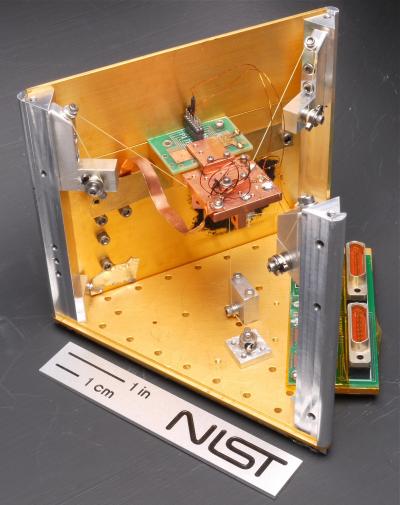Mar 11 2013
Researchers at the National Institute of Standards and Technology (NIST) have demonstrated a solid-state refrigerator that uses quantum physics in micro- and nanostructures to cool a much larger object to extremely low temperatures.
 NIST's prototype solid-state refrigerator uses quantum physics in the square chip mounted on the green circuit board to cool the much larger copper platform (in the middle of the photo) below standard cryogenic temperatures. Other objects can also be attached to the platform for cooling. Credit: Schmidt/NIST
NIST's prototype solid-state refrigerator uses quantum physics in the square chip mounted on the green circuit board to cool the much larger copper platform (in the middle of the photo) below standard cryogenic temperatures. Other objects can also be attached to the platform for cooling. Credit: Schmidt/NIST
What's more, the prototype NIST refrigerator, which measures a few inches in outer dimensions, enables researchers to place any suitable object in the cooling zone and later remove and replace it, similar to an all-purpose kitchen refrigerator. The cooling power is the equivalent of a window-mounted air conditioner cooling a building the size of the Lincoln Memorial in Washington, D.C.
"It's one of the most flabbergasting results I've seen," project leader Joel Ullom says. "We used quantum mechanics in a nanostructure to cool a block of copper. The copper is about a million times heavier than the refrigerating elements. This is a rare example of a nano- or microelectromechanical machine that can manipulate the macroscopic world."
The technology may offer a compact, convenient means of chilling advanced sensors below standard cryogenic temperatures—300 milliKelvin (mK), typically achieved by use of liquid helium—to enhance their performance in quantum information systems, telescope cameras, and searches for mysterious dark matter and dark energy.
As described in Applied Physics Letters,* the NIST refrigerator's cooling elements, consisting of 48 tiny sandwiches of specific materials, chilled a plate of copper, 2.5 centimeters on a side and 3 millimeters thick, from 290 mK to 256 mK. The cooling process took about 18 hours. NIST researchers expect that minor improvements will enable faster and further cooling to about 100 mK.
The cooling elements are sandwiches of a normal metal, a 1-nanometer-thick insulating layer, and a superconducting metal. When a voltage is applied, the hottest electrons "tunnel" from the normal metal through the insulator to the superconductor. The temperature in the normal metal drops dramatically and drains electronic and vibrational energy from the object being cooled.
NIST researchers previously demonstrated this basic cooling method** but are now able to cool larger objects that can be easily attached and removed. Researchers developed a micromachining process to attach the cooling elements to the copper plate, which is designed to be a stage on which other objects can be attached and cooled. Additional advances include better thermal isolation of the stage, which is suspended by strong, cold-tolerant cords.
Cooling to temperatures below 300 mK currently requires complex, large and costly apparatus. NIST researchers want to build simple, compact alternatives to make it easier to cool NIST's advanced sensors. Researchers plan to boost the cooling power of the prototype refrigerator by adding more and higher-efficiency superconducting junctions and building a more rigid support structure.